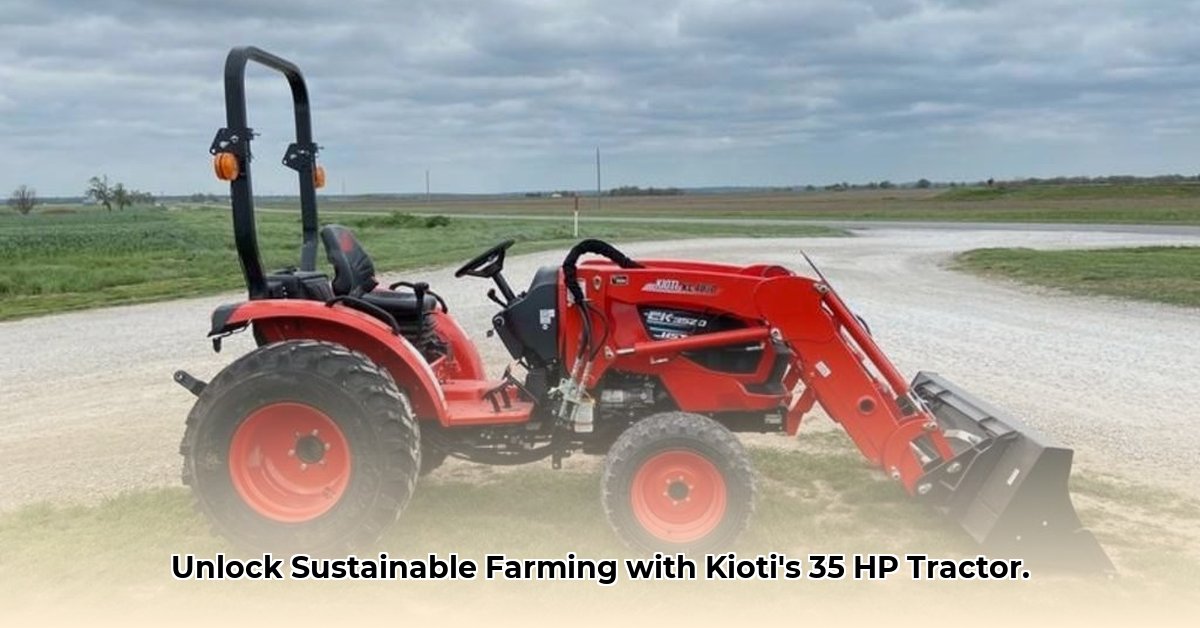
Choosing the right tractor is crucial for sustainable agriculture, balancing productivity with environmental responsibility. The Kioti CK35, a 35-horsepower compact tractor, aims to meet this need. This article examines its features, performance (based on available data), and suitability for eco-conscious farming practices. We also highlight the critical need for more transparent data from manufacturers to fully assess the long-term sustainability of such equipment. For more Kioti tractor reviews, see this helpful resource.
Key Features and Specifications: A Detailed Look at the Kioti CK35
The Kioti CK35, particularly models like the CK3520SE, is marketed towards smaller farms prioritizing sustainability. Its Tier 4 CRDI engine promises reduced noise pollution and potentially improved fuel efficiency compared to older models. However, a significant limitation is the lack of publicly available, detailed fuel consumption data under varied operating conditions (e.g., plowing rocky versus soft soil). This makes a precise assessment of its long-term running costs challenging.
Despite this data gap, several features stand out. Its synchronized shuttle shift significantly increases operator efficiency, reducing fatigue during long workdays. The intuitive single-lever joystick for the front loader simplifies operation, enhancing overall productivity. The operator station’s comfortable design directly contributes to reduced fatigue and improved farmer well-being. Finally, a generous 13.4-inch ground clearance allows for operation in uneven terrain, showcasing its versatility.
Performance Assessment and Limitations: A Balanced Perspective
Evaluating the Kioti CK35's actual field performance is difficult due to insufficient publicly available data. While advertised as fuel-efficient, concrete evidence supporting this claim remains elusive. Similarly, horsepower performance data under various load conditions is missing. This lack of information hinders a precise evaluation of its overall environmental impact.
However, anecdotal evidence points towards its user-friendly design and comfortable ergonomics contributing to efficient operation. But this alone is inadequate for a comprehensive sustainability assessment. To definitively evaluate its fuel efficiency and long-term environmental impact, additional data is crucial.
Comparison with Competitor Tractors: A Challenging Task
Direct comparisons with competitors are hampered by a lack of standardized fuel efficiency and performance data across the industry. Many manufacturers don't provide the granular data necessary for objective comparisons. However, the Kioti CK35’s focus on operator comfort and maneuverability suggests it could be competitive for sustainable farming, particularly for smaller operations handling varied terrain.
Actionable Insights: Recommendations for Various Stakeholders
To foster better transparency and facilitate informed decision-making, the following steps are crucial:
For Farmers:
- Demand Transparency: Directly request detailed fuel consumption and performance data from Kioti and other manufacturers.
- Invest Wisely: Consider government grants or low-interest loans to offset the initial cost of sustainable equipment upgrades.
- Track and Share Data: Meticulously record operating costs and environmental impacts. Share this data to create a broader understanding of real-world performance.
For Kioti (Manufacturer):
- Publish Comprehensive Data: Publicly release detailed fuel consumption data across varying soil types and workloads.
- Emphasize Sustainability: Promote the tractor's eco-friendly features using verifiable data in marketing materials.
- Invest in R&D: Explore innovative, more sustainable options like electric or hybrid drive systems.
For Government Agencies:
- Incentivize Sustainability: Implement programs and incentives encouraging the adoption of fuel-efficient agricultural equipment.
- Fund Research: Support funding for research on sustainable agricultural technologies.
- Offer Tax Benefits: Consider providing subsidies or tax breaks for farmers purchasing sustainable equipment.
Conclusion: The Need for Transparency in Sustainable Agriculture
The Kioti CK35 shows promise for sustainable agriculture, but its assessment is limited by the absence of comprehensive performance data. Greater transparency from manufacturers and proactive data collection by farmers are vital for a complete evaluation of its long-term sustainability and its role in environmentally friendly farming practices. A more standardized approach to data reporting across the industry is essential to aid informed decisions and support the transition to more sustainable agriculture.